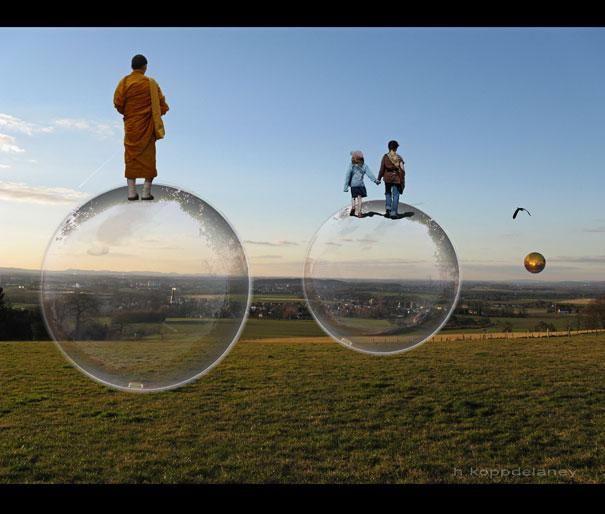The dream - one of the most mysterious phenomena of human existence.
 Bashny.Net
Bashny.Net
At certain moments in history dreams attached to a special, sacred meaning. So, during the Roman Empire, some dreams became the subject of investigation and analysis in the Senate, as were seen as messages from the gods. The interpreters of dreams often accompanied generals in military campaigns, in order to help the rulers see in dreams good or bad omens about the outcome of the battle.

The cultural heritage of the role of dreams is difficult to overestimate, because this topic has become the basis for creating a number of masterpieces of literature, music and painting.
So what is a dream in terms of physiology, and the remarkable process of dreaming?
1. We remember only 10% of our dreams.
Within five minutes after waking up, we have a real chance to "catch its tail" about half of the plot of sleep, but after ten minutes 90% of the content will be lost, and the meaning of the dream fall apart like a house of cards.
2. Blind people have dreams
People who have lost their vision for life, dreaming equal footing with sighted people. People who are blind from birth do not see the images in the usual sense, but just going through different emotions in dreams: the images are formed in their subconscious through smells, sounds and tactile sensations.

3. All sleeping - Dreamers
The complete absence of dreams is a manifestation of some severe mental illness. All normal people, plunging into slumber, dreaming, but most of their waking instantly forgets.
4. In the dream, we only see the real people
Our subconscious mind is not able to independently and randomly generated faces. This means that absolutely all the strangers in your dreams we once saw, but did not remember. It may equally be a man, a year ago, who was riding in front of you with a subway car, or a woman in the background in the through boring episode of the film. Over the lifetime under different circumstances by us are millions of people and, therefore, our brain never experience a shortage of new actors in the most unexpected roles in the scenario of our dreams.

5. Not everyone can see colorful dreams as much as 12% of sighted people see only monochrome dreams. More precisely, it was not until the mid-sixties. Later, the percentage of people who see dreams exclusively in black and white, fell by 4.4% of the total sample of the study. The researchers suggest that the reason for this trend is the ubiquity of color television broadcast.
6. Dreams are symbolic
All probably know the anecdote about Sigmund Freud and his niece: "Sometimes a banana - it's just a banana." But joking aside, dreams can not be interpreted in a straight line, since any object in a dream may be a symbol of another object. Through our subconscious dream speaks to us the language of metaphors and symbols; some of them have global unambiguous interpretation on all continents, others contain only we clear signs.

7. Dreams emotionally painted
Sadly, but the most common emotion experienced by a dream, a longing and despair, and, in general, negative emotions in dreams prevail over the positive.
8. From four to seven
In one night we see four to seven dreams that amount takes from half an hour and two hours.
9. Animals dreaming
According to research conducted on different groups of animals, many of them in a dream experienced similar modes of neural activity. Thinking highly of animal impulses during sleep on the drawing do not differ from men, from which it can be confident conclusion - animals too have dreams, and many of them are going through what he saw at least emotionally, rather than reality.

10. Paralysis of the body during sleep
Scientists have identified two key a sleep phase of sleep - a deep sleep and sleep with rapid eye movement (REM). REM-phase - it is absolutely normal sleep from 20 to 25% of the time during sleep.
It is in REM sleep a person dreams; to avoid involuntary physical movements of the body, the subconscious literally paralyzes him at the time of REM-sleep phase, but for unknown reasons, this mechanism often is faltering.
11. "Broken Phone»
Our brain interprets the different external stimuli in the process of dreaming and very successfully weaves them into the fabric of meaning sleep.
12. Women and men Dreamers different
In two cases out of three men in a dream talking, fighting or establishes a relationship with a man. In dreams there is no misalignment of the women, and they see approximately the same number of women and men. And one more predictable difference - men in their dreams is much more aggressive than women.
13. Prophetic dreams

According to several studies in large samples from 18% to 38% of respondents at least once dreamed-prediction, and 70% of people have experienced deja vu. Belief in the possibility of prophetic dream spread almost everywhere - from 63 to 98% of respondents in the different countries of the world.
14. Snoring occurs only in REM sleep
Everything is simple - either Dreamers, or snoring.
15. orgasmic dreams
Observing the plot of sleep, you can not just excited, but also to experience a full orgasm.

The cultural heritage of the role of dreams is difficult to overestimate, because this topic has become the basis for creating a number of masterpieces of literature, music and painting.
So what is a dream in terms of physiology, and the remarkable process of dreaming?
1. We remember only 10% of our dreams.
Within five minutes after waking up, we have a real chance to "catch its tail" about half of the plot of sleep, but after ten minutes 90% of the content will be lost, and the meaning of the dream fall apart like a house of cards.
2. Blind people have dreams
People who have lost their vision for life, dreaming equal footing with sighted people. People who are blind from birth do not see the images in the usual sense, but just going through different emotions in dreams: the images are formed in their subconscious through smells, sounds and tactile sensations.

3. All sleeping - Dreamers
The complete absence of dreams is a manifestation of some severe mental illness. All normal people, plunging into slumber, dreaming, but most of their waking instantly forgets.
4. In the dream, we only see the real people
Our subconscious mind is not able to independently and randomly generated faces. This means that absolutely all the strangers in your dreams we once saw, but did not remember. It may equally be a man, a year ago, who was riding in front of you with a subway car, or a woman in the background in the through boring episode of the film. Over the lifetime under different circumstances by us are millions of people and, therefore, our brain never experience a shortage of new actors in the most unexpected roles in the scenario of our dreams.

5. Not everyone can see colorful dreams as much as 12% of sighted people see only monochrome dreams. More precisely, it was not until the mid-sixties. Later, the percentage of people who see dreams exclusively in black and white, fell by 4.4% of the total sample of the study. The researchers suggest that the reason for this trend is the ubiquity of color television broadcast.
6. Dreams are symbolic
All probably know the anecdote about Sigmund Freud and his niece: "Sometimes a banana - it's just a banana." But joking aside, dreams can not be interpreted in a straight line, since any object in a dream may be a symbol of another object. Through our subconscious dream speaks to us the language of metaphors and symbols; some of them have global unambiguous interpretation on all continents, others contain only we clear signs.

7. Dreams emotionally painted
Sadly, but the most common emotion experienced by a dream, a longing and despair, and, in general, negative emotions in dreams prevail over the positive.
8. From four to seven
In one night we see four to seven dreams that amount takes from half an hour and two hours.
9. Animals dreaming
According to research conducted on different groups of animals, many of them in a dream experienced similar modes of neural activity. Thinking highly of animal impulses during sleep on the drawing do not differ from men, from which it can be confident conclusion - animals too have dreams, and many of them are going through what he saw at least emotionally, rather than reality.

10. Paralysis of the body during sleep
Scientists have identified two key a sleep phase of sleep - a deep sleep and sleep with rapid eye movement (REM). REM-phase - it is absolutely normal sleep from 20 to 25% of the time during sleep.
It is in REM sleep a person dreams; to avoid involuntary physical movements of the body, the subconscious literally paralyzes him at the time of REM-sleep phase, but for unknown reasons, this mechanism often is faltering.
11. "Broken Phone»
Our brain interprets the different external stimuli in the process of dreaming and very successfully weaves them into the fabric of meaning sleep.
12. Women and men Dreamers different
In two cases out of three men in a dream talking, fighting or establishes a relationship with a man. In dreams there is no misalignment of the women, and they see approximately the same number of women and men. And one more predictable difference - men in their dreams is much more aggressive than women.
13. Prophetic dreams

According to several studies in large samples from 18% to 38% of respondents at least once dreamed-prediction, and 70% of people have experienced deja vu. Belief in the possibility of prophetic dream spread almost everywhere - from 63 to 98% of respondents in the different countries of the world.
14. Snoring occurs only in REM sleep
Everything is simple - either Dreamers, or snoring.
15. orgasmic dreams
Observing the plot of sleep, you can not just excited, but also to experience a full orgasm.
Tags
See also
The most mysterious places on the planet
Most mysterious scientific phenomena
Most found the oldest bacteria, the existence of which it is known to scientists.
The largest swimming pool in the Soviet Union and one of the biggest pools in the world
Dreams - one of the most mysterious and unexplored areas of the human psyche
"Biosphere 2" - a paradise on earth
Wikipedia is the most extensive place of gathering knowledge in the history of mankind
... "One of the most perfect and unique diamonds in the world"
Conspiracy Theory: 15 most mysterious death of the famous
The five secrets of the most mysterious paintings of the Tretyakov gallery

















